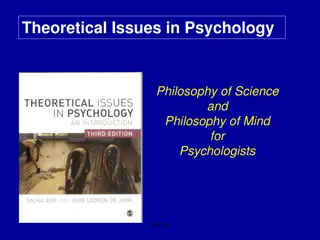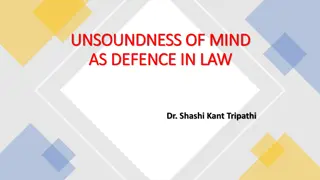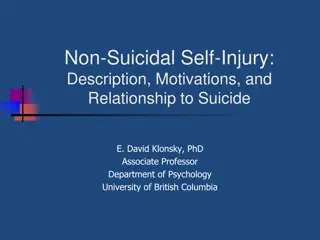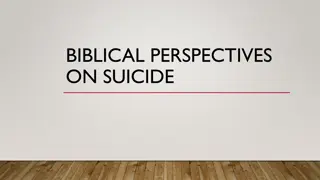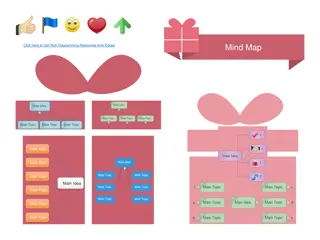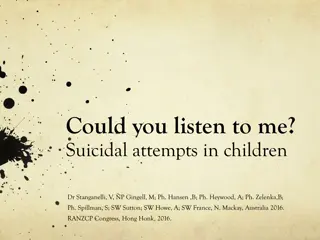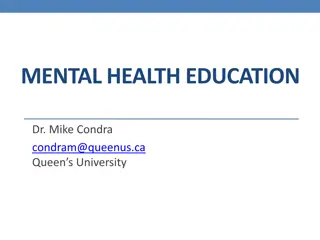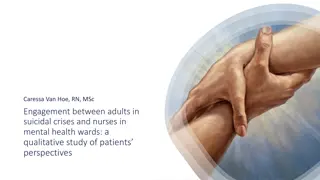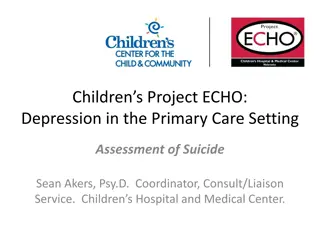Understanding the Suicidal Mind: Insights and Perspectives
Exploring the complex facets of suicidal behavior, this content delves into the psychological pain, personality traits, and theories associated with individuals contemplating or attempting suicide. It sheds light on the underlying emotional turmoil driving suicidal actions and highlights the need for a deeper understanding of mental health and coping mechanisms to prevent such tragic outcomes.
Download Presentation

Please find below an Image/Link to download the presentation.
The content on the website is provided AS IS for your information and personal use only. It may not be sold, licensed, or shared on other websites without obtaining consent from the author. Download presentation by click this link. If you encounter any issues during the download, it is possible that the publisher has removed the file from their server.
E N D
Presentation Transcript
THE SUICIDAL MIND Mary Lebioda, RN, MA, LLP Consultant for School Health and Related Services, Macomb Intermediate School District
SUICIDE IS THE RESULT OF INCREASED PAIN AND LACK OF HEALTHY COPING SKILLS
ADJECTIVES OF THE SUICIDAL PERSONALITY Carefree Musical Intelligent Musical Successful Loved Life Lived fullest Giving Outdoor type Hands on work/hobbies Artistic Caring Quiet/withdrawn Funny Happy Loving Creative Sensitive Gentle
SUICIDAL FOLKS ARE Their personality traits are not what one would expect.. Complicated to foresee who may be suicidal
THEORIES OF UNDERSTANDING SUICIDE Dr. Edwin Shneidman-Founder of the American Academy of Suicidology Dr. Thomas Joiner-Interpersonal- Psychological Theory of Suicide Behavior
DR. SCHNEIDMANS MODEL- PSYCHOLOGICAL PAIN Suicide is almost always driven by unbearable emotional pain Psychache. Results from frustrated psychological needs. Person obsesses over what is wrong with his/her life
SUICIDAL BEHAVIOR & PSYCHOLOGICAL PAIN Psychiatric Illness Co-morbidity Personality Disorder/Traits Neurobiology Impulsiveness Substance Use/Abuse Hopelessness Suicide Severe Medical Illness Family History Access To Weapons Psychodynamics/ Psychological Vulnerability Life Stressors Suicidal Behavior
SUICIDAL BEHAVIOR AND PSYCHOLOGICAL PAIN Individuals contemplating or attempting suicide do not want to die. They want to end their emotional pain. Suicide is behavior driven by emotional pain in the mind. Substance abuse is often an interruption for psychache.
TEN COMMON ELEMENTS (PRESENT IN 95 OUT OF 100 COMPLETED SUICIDES) The common purpose of suicide is to seek a solution. Not a random act Suicide is a way out of some unbearable dilemma. Attraction to suicide as a solution may be increased by a family history of similar behavior.
COMMON ELEMENTS The common goal of suicide is cessation of consciousness. People who die by suicide see the end of the conscious experience. This ends the endless stream of distressing thoughts with which they are preoccupied. Suicide offers oblivion.
COMMON ELEMENTS The common stimulus in suicide is intolerable psychological pain. Excruciating negative emotions frequently serve as the foundation for self-destructive behavior. These emotions may arise from any number of sources.
COMMON ELEMENTS The common stressor in suicide is frustrated psychological needs. People with high standards and expectations are especially vulnerable to ideas of suicide when progress toward these goals is suddenly frustrated. People who attribute failure or disappointment to their own shortcomings may come to view themselves as worthless, incompetent or unlovable.
COMMON ELEMENTS The common emotion in suicide is hopelessness- helplessness. A pervasive sense of hopelessness, defined in terms of pessimistic expectations about the future, is even more important than other forms of negative emotions such as anger and depression. The suicidal person is convinced that absolutely nothing can be done to improve his or her situation; no one can help.
COMMON ELEMENTS The common internal element in suicide is ambivalence. Many people who contemplate suicide, including those that eventually kill themselves, have ambivalent feelings about the decision. They are sincere in their wish to die, but they simultaneously wish that they could find another way out of their dilemma.
COMMON ELEMENTS The common cognitive state in suicide is constriction. Suicidal thoughts and plans are frequently associated with a rigid and narrow pattern of cognitive activity that is comparable to tunnel vision. The suicidal person is temporarily unable or unwilling to engage in effective problem-solving behaviors and may see his options as all or nothing.
COMMON ELEMENTS The common action in suicide is escape. Suicide provides a definitive way to escape from intolerable circumstances, which include painful self-awareness.
COMMON ELEMENTS The common interpersonal act in suicide is communication of intention. One of the most harmful myths about suicide is the notion that people who really want to kill themselves don t talk about it. Schneidman estimates that in at least 80% of completed suicides, the people provide verbal or behavioral clues that indicate clearly their lethal intentions.
COMMON ELEMENTS The common consistency in suicide is with life-long coping patterns. During crisis that precipitate suicidal thoughts, people generally employ the same response patterns that they have used throughout their lives. Source: Thomas F. Oltmanns, Robert E. Emers, Univeristy of Virginia
STAGES OF THE SUICIDAL MIND- THE PROCESS 1. Inner Turmoil 2. Tunnel Vision 3. Final Decision
INNER TURMOIL Ambivalence - strongest feeling. Torn feelings wanting to live and die at same time, alternating back & forth making plans in both directions. Inability to communicate this inner turmoil, intensifies self helplessness & hopelessness. May seek help, give sporadic clues, begin form plan. People important to them still in their vision and keep them here and alive.
TUNNEL VISION Overwhelmed with negative feelings of self & future. Hopelessness and helplessness increase. Ambivalence decreases & tunnel vision increases. Clues and treatment stop, detachment and isolation begin. Need to push people away; belief unlovable & unworthy. More time spent on planning death increases. Love ones are not forgotten or less loved, simply not in picture (T.V.)
FINAL DECISION May appear sudden uplift happy, euphoric or calm having made decision; portraying their problems relieved/solved. Family/friends interpret these changes as positive; feeling relief due to signs depicting person is indeed feeling better.
DR. THOMAS JOINER INTERPERSONAL-PSYCHOLOGICAL THEORY
PERCIEVED BURDENSOMENESS The view that one s existence burdens the family, friends, and/or society. This view produces the idea that my death will be worth more than my life to family, friends, society, etc.
FAILED BELONGINGNESS One is alienated from others and not an integral part of a family, circle of friends or other valued group.
IMPLICATIONS FOR PREVENTION Perceived Burdensomeness and failed belonging are more fluid, dynamic and changeable. They represent potential leverage points for suicide prevention efforts.
No amount of love from others- and there was a lot - could help. Wasn t much left of me and I believed everyone would be better off without me. Kay Jamison; Night Falls Fast 28
STORY OF HOPE AND RECOVERY TERRY WISE
S. T. O. P. See Talk Offer Persist
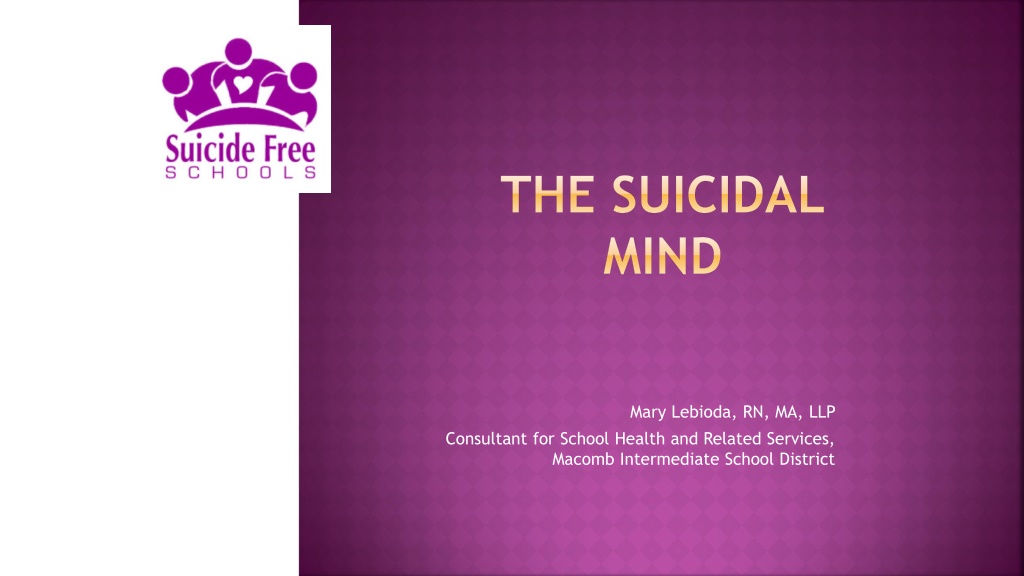

![[PDF⚡READ❤ONLINE] Zen Mind, Beginner's Mind: 50th Anniversary Edition](/thumb/20459/pdf-read-online-zen-mind-beginner-s-mind-50th-anniversary-edition.jpg)




